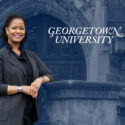![]() For the past 28 years, JBHE has collected Black student admissions data from the highest-ranked liberal arts colleges. Over this long period, there have been 13 years when Amherst College in Massachusetts reported the highest percentage of Black first-year students. On six occasions, Wesleyan University in Middletown, Connecticut, had enrolled the highest percentage of Black first-year students.
For the past 28 years, JBHE has collected Black student admissions data from the highest-ranked liberal arts colleges. Over this long period, there have been 13 years when Amherst College in Massachusetts reported the highest percentage of Black first-year students. On six occasions, Wesleyan University in Middletown, Connecticut, had enrolled the highest percentage of Black first-year students.
Five years ago, there were 87 Black first-year students at Amherst. They made up a whopping 18.2 percent of the first-year class. At that time, this was the largest percentage of Black first-year students at any of the high-ranking liberal arts colleges in the history of the JBHE survey. A year ago, Amherst College sat on top of the survey and the college set a new standard. There were 81 Black students in the 2020 entering class. They make up 18.7 percent of the first-year class. This was the largest percentage of Black students in an entering class in the history of our surveys of both high-ranking liberal arts colleges and the nation’s leading research universities.
Now Amherst College has set a new standard. There are 100 Black students in this year’s entering class. They make up 19.5 percent of the Class of 2025.
Black First-Year Enrollments at High-Ranking Liberal Arts Colleges, 2021
School | Total Enrollment | Black Enrollment | % Black |
|---|---|---|---|
| Amherst College | 514 | 100 | 19.5 |
| Harvey Mudd College | 231 | 41 | 17.7 |
| Barnard College | 769 | 118 | 15.3 |
| Swarthmore College | 454 | 68 | 14.9 |
| Pomona College | 451 | 61 | 13.5 |
| Haverford College | 411 | 51 | 12.4 |
| Middlebury College | 797 | 89 | 11.2 |
| Bates College | 553 | 59 | 10.7 |
| Wesleyan University | 919 | 95 | 10.3 |
| Bowdoin College | 517 | 51 | 9.9 |
| Macalester College | 601 | 59 | 9.8 |
| Oberlin College | 777 | 71 | 9.1 |
| Washington & Lee Univ. | 484 | 39 | 8.1 |
| Vassar College | 679 | 54 | 8.0 |
| Colgate University | 884 | 69 | 7.8 |
| Davidson College | 552 | 39 | 6.9 |
| Hamilton College | 533 | 35 | 6.6 |
| Lafayette College | 782 | 43 | 5.5 |
| Grinnell College* | 471 | 24 | 5.1 |
| Smith College* | 676 | 34 | 5.1 |
| Scripps College | 328 | 15 | 4.6 |
| Bucknell University* | 1,027 | 33 | 3.2 |
| Mt. Holyoke College | 608 | 18 | 3.0 |
While the achievement of Amherst College in attracting Black students to rural Massachusetts, can not be overstated, an equally compelling tale has taken place at Harvey Mudd College in Claremont, California, which bills itself as the nation’s top liberal arts college of engineering, science, and mathematics.
Thus, it may be a surprise to many readers, that Harvey Mudd College ranks second in our survey this year with an entering class that is 17.7 percent Black. The 41 Black first-year students are more than double the number from a year ago. A year ago, Blacks made up 8.6 percent of the students in the entering class. In 2009, Harvey Mudd College ranked last in our survey in the Black percentage of first-year students. That year there were only three black students in the entering class. They made up just 1.4 percent of all entering students.
In 2019, Harvey Mudd College accepted only 13.7 percent of all applicants. But the acceptance rate for Black applicants was 35 percent. Blacks made up 10.7 percent of the entering class. For the past two years, the college declined to provide JBHE with data on the acceptance rate of Black students.
Barnard College in New York City has shown great progress over the past several years. This year, Barnard has an entering class that is 15.3 percent Black. This places the women’s college in third place in our survey. A year ago Blacks were 10.9 percent of all first-year students.
Swarthmore College in Pennsylvania ranks fourth in our survey this year, down from third last year. This is the sixth year in a row that Swarthmore has ranked in the top 5 in our survey. There are 68 Black first-year students at the college this year, making up 14.9 percent of the entering class.
Five years ago, for the first time in the history of our survey, Pomona College in Claremont, California, had the highest percentage of Black students in the entering classes at the nation’s leading liberal arts colleges. There were 65 Black first-year students at Pomona College that year. They made up 15.8 percent of the entering class. Four years ago, Pomona dropped to fourth place with an entering class that was 12.6 percent Black. Three years ago, once again Pomona sat atop our rankings. Pomona had 67 Black first-year students, up from 52 the previous year. Blacks were 16.3 percent of the first-year class. For the past two years, Pomona ranked in second place. Pomona College ranks in fifth place this year with an entering class that is 13.5 percent Black.
Four other liberal arts colleges that responded to our survey had entering classes that were more than 10 percent Black. They are Haverford College in Pennsylvania, Middlebury College in Vermont, Bates College in Maine, and Wesleyan University in Connecticut.
In 2009, only three of the nation’s high-ranking liberal arts colleges had entering classes that were at least 10 percent Black. Two years ago there were nine. A year ago despite the pandemic, there were eight leading liberal arts colleges that have an entering class that was at least 10 percent Black. This year, there are also eight colleges with an entering class that is at least 10 percent Black.
Six leading liberal arts colleges have entering classes that are less than 6 percent Black. They are Lafayette College, Grinnell College, Smith College, Bucknell University, Scripps College, and Mount Holyoke College.
One-Year Gainers and Losers in Black First-Year Enrollments at High-Ranking Liberal Arts Colleges
| School | 2020 | 2021 | % Change |
|---|---|---|---|
| Bates College | 23 | 59 | +156.5 |
| Harvey Mudd College | 18 | 41 | +127.8 |
| Lafayette College | 26 | 43 | +65.4 |
| Oberlin College | 44 | 71 | +61.4 |
| Middlebury College | 56 | 89 | +58.9 |
| Barnard College | 75 | 118 | +57.3 |
| Hamilton College | 24 | 35 | +45.8 |
| Davidson College | 29 | 39 | +34.5 |
| Washington & Lee Univ. | 30 | 39 | +30.0 |
| Wesleyan University | 70 | 95 | +26.3 |
| Swarthmore College | 54 | 68 | +25.9 |
| Amherst College | 81 | 100 | +23.5 |
| Vassar College | 48 | 54 | +12.5 |
| Colgate University | 63 | 69 | +9.5 |
| Pomona College | 59 | 61 | +3.3 |
| Bowdoin College | 50 | 51 | +2.0 |
| Macalester College | 58 | 59 | +1.7 |
| Smith College | 38 | 34 | -10.5 |
| Scripps College | 17 | 15 | -11.8 |
| Bucknell University | 48 | 33 | -31.3 |
| Mt. Holyoke College | 36 | 18 | -50.0 |
Note: Only colleges that reported data in both 2020 and 2021 are included.
Source: JBHE Research Department
In 2020, enrollments were down at many liberal arts colleges due to the pandemic. So it is no surprise that in 2021, Black enrollments were up at almost all leading liberal arts colleges. In some cases, the increases were spectacular. At both Bates College in Maine and Harvey Mudd College in California, the number of Black students is more than double the number from a year ago. The number of Black students is up more than 50 percent at Lafayette College, Oberlin College, Middlebury College, and Barnard College.
Only Smith College, Bucknell University, Scripps College, and Mount Holyoke show declines in the number of Black first-year students from a year ago.
A Note on Methodology
Before we continue with the results, it is important to mention how the U.S. Department of Education collects data on the race of undergraduates. Before a change was made several years ago, students who reported more than one race (including African American) were included in the figures for Black students. This is no longer the case. Thus, students who self-identify as biracial or multiracial with some level of African heritage are no longer classified as Black by the Department of Education.
JBHE surveys have always asked respondents to include all students who self-identify as having African American or African heritage including those who are actually from Africa. JBHE has always maintained that biracial, multiracial, and Black students from Africa add to the diversity of a college campus. And including these students in our figures offers college-bound Black students a better idea of what they can expect at a given college or university. In order that we can compare our current data to past JBHE surveys, we have continued to ask colleges and universities to include all students who identify themselves as having African American or African heritage.
Some of our responding liberal arts colleges chose to report results that correspond with official Department of Education figures. They are indicated on the table with an asterisk. It should be noted that if biracial, multiracial, and Black foreign students were included in the Black percentage of students in the first-year classes at these institutions, the overall percentage of Black students would undoubtedly be higher.
Black Student Acceptance Rates
In the past, almost all leading liberal arts colleges divulged data on Black student acceptance rates. In recent years, the number of liberal arts colleges that have refused to divulge the data has grown. The recent litigation involving the admissions practices of Harvard University concerning Asian American students, which is now before the Supreme Court, appears to have struck a nerve in higher education circles. Colleges and universities increasingly seem to want to hold their cards close to their vests and not add fuel to efforts to challenge affirmative action admissions policies.
Not too long ago, all of the top liberal art colleges in our survey reported Black acceptance rates to JBHE. This year we have acceptance rate data on only 14 liberal arts colleges. Three of the four colleges that have the largest percentages of Black students have not furnished acceptance rate data.
Nine years ago, for the first time in the history of the JBHE survey of liberal arts colleges, more responding colleges had a lower acceptance rate for Black students than their overall acceptance rate compared to the number of colleges that had a Black acceptance rate that was higher than their overall rate. This is the tenth year in a row when more liberal arts colleges that chose to divulge this data showed a lower acceptance rate for Black students than the acceptance rate for students overall. In most cases the differences were small. But Middlebury College in Vermont had a Black acceptance rate of 31.5 percent, compared to an overall acceptance rate of just 15.7 percent. Scripps College also has a Black acceptance rate that was significantly higher than the rate for all students.
Racial Differences in Acceptance Rates at High-Ranking Liberal Arts Colleges, 2021
| School | Overall Acceptance Rate | Black Acceptance Rate | Difference |
|---|---|---|---|
| Middlebury College | 15.7 | 31.5 | +15.8 |
| Scripps College | 29.5 | 42.6 | +13.1 |
| Mt. Holyoke College | 52.3 | 55.9 | +3.6 |
| Grinnell College | 10.5 | 13.6 | +3.1 |
| Bowdoin College | 8.8 | 11.5 | +2.7 |
| Pomona College | 6.6 | 9.3 | +2.7 |
| Barnard College | 11.5 | 13.6 | +2.1 |
| Bates College | 17.3 | 14.5 | -2.8 |
| Wesleyan University | 19.3 | 16.3 | -3.0 |
| Haverford College | 17.8 | 14.6 | -3.2 |
| Hamilton College | 14.1 | 7.8 | -6.3 |
| Colgate University | 17.2 | 9.1 | -8.1 |
| Bucknell University | 34.5 | 23.5 | -11.0 |
| Macalester College | 31.2 | 18.8 | -12.4 |
On the other extreme, at Macalester College in Minnesota, 31.2 percent of all students were accepted but only 18.8 percent of Black students were admitted. At Bucknell University, 34.5 percent of all applicants were accepted but only 23.5 percent of Black applicants were accepted.
While no firm conclusions can be made, the fact that for the past 10 years there are now more colleges with overall acceptance rates that are higher than Black acceptance rates, causes one to wonder if there has been some curtailment in colleges’ consideration of race in admissions decisions. Or it may be that the colleges that have a much higher acceptance rate for Black students than they do for the applicant pool as a whole, are unwilling to publicize this information in fear of litigation or do not wish to anger some contributing alumni who are not in favor of race-sensitive admissions.












Thank you for this timely information. My question-is it money that truly makes the difference in the recruitment and retention of black students at these rural and al white institutions. What, how, where are they recruiting and what is the presence of admissions/enrollment/financial aid professions that a are of color and out on the road? Thank you for doing this important work.
Dr. Mathis asks very important inquiries regarding the recruitment, financial aid, retention and presence professions of color involved. The fiduciary allocation to supporting Black students upon entering and persisting. Also will these institutions take away from HBCU student enrollment? Harvey Mudd has excelled in their graduation rates and from past research on the institution they have heavily involved in outreach within lower income and minority communities with bridge programs and connecting to middle school and High schools to develop students interested in STEM and fostering their interests. I am hoping that instituitons are making those efforts early on to ensure that these students are cultivated to ensure their college preparedness for succesful degree completion. This will be the way for Black graduates and other minorities to grow in professions that do not have much diversity.